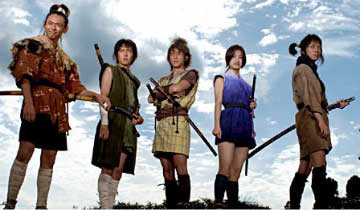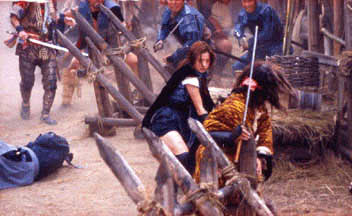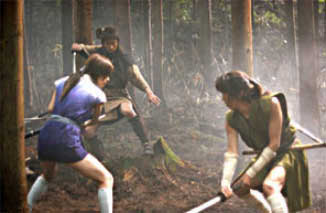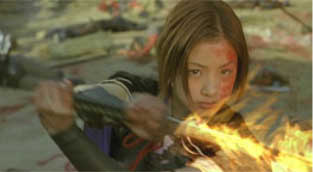

Ryuhei Kitamura’s “Azumi” (2003) is the sledgehammer of female action films, shattering the standards established by previous titles in a two-and-a-half-hour onslaught of utter mayhem. Kitamura serves up a seven-course feast of violence that traces the fate of “Azumi” (Aya Ueto) and her nine young male companions who are trained from childhood as assassins. Their sensei is charged with raising an elite team from scratch, for the purpose of eliminating potential challengers to the Tokugawa Shogunate. “Azumi” is picked up by this band as a newly orphaned child found crouching beside her dead mother.

Raised in complete isolation and trained in the arts of Kenjutsu and Ninjutsu, the little band’s first adult task is to pair off into two-person teams with their respective lifetime best friends. “Azumi” pairs with the handsome, self-confident young man who, as a child, had rescued her from near-certain death. But what appears to be an overture to subsequent romance is but a feint, cruel as a master swordsman dropping his guard. Before embarking on their mission to assassinate three warlords, the group must pass two tests set by their revered sensei and father figure. The first is to kill their new partner. The second is to dispassionately witness the massacre of the helpless population of a village, without intervening. Only the surviving five are judged to possess the requisite skill and ruthlessness to be assassins.
Thus begins a process of virtually Darwinian selection by attrition that opens with “Azumi” as a helpless child, and culminates with her heroic stance as virtually the sole survivor out of many hundreds of screen deaths. Aya Ueto’s realization of “Azumi” is intriguingly ambiguous. Despite her undoubted physical beauty, she remains an emotionally neutral, asexual figure. Of the ten who started out, she proves to be the ultimate warrior. Steeped in Budo and loyalty, “Azumi” bores in on her targets against all odds – a blood-spattered kamikaze whose katana harvests those standing between her and the mission.

“Azumi’s” short tunic, bare legs and easy companionship with males suggest that she was raised essentially as a boy. When the five assassins initially charged with the mission encounter a troupe of itinerant acrobats – also raised in these skills from childhood – “Azumi” befriends one of the women and helps save her from a brutal attempted rape that kills all the others. Her new friend attempts to feminize “Azumi” – who knows nothing of the wider world – by dressing her in a kimono, applying makeup and imploring her to renounce violence. Despite “Azumi’s” androgynous persona, the film nevertheless acknowledges the inevitability of gender differences. During training, as “Azumi’s” companions eagerly rush indoors for their meal, she gazes at the sky and wonders aloud what happens to the stars during the daytime. Her natural spirit of inquiry and reflection eventually encompass the morality of her mission, leading her to discard the way of the sword as urged by her new friend. However, as the two kimono-clad women embark on a journey to forge a new life, they are attacked by a band of warriors intent on rape. “Azumi’s” defense is horrifically efficient, culminating in a katana slash across the mouth of the band’s leader. This pivotal moment cements her character’s complete surrender to a warrior destiny, and only foregrounds the necessity of unyielding vigilance and strength. Yield a fraction, and male enemies may seize all. As the two women part ways, “Azumi” exchanges a good luck talisman for a foreign-made cape – from “across the ocean” of which she knows nothing. Thus attired, her character assumes a distinctively more heroic pose. The cape over leather also conveys a hint of costume fetishism. After donning the mantle of the foreign cloak, it is evident that “Azumi” will never again wear the kimono or submit to the will of others.

The extended final battle sequences of the film involve a maelstrom of well-choreographed and occasionally brilliantly filmed combat. The camera seemingly floats in three-dimensional space, freezing and speeding time, but pausing to zoom on the moment of facial calm before and after each katana strike, or on the swift flick of blood droplets from the blade. Eventually, “Azumi” confronts the other survivor of this battle that has destroyed a small army. This character is an utterly evil sadist, an unbeaten swordsman who wears delicate white robes, very long hair and extensive facial makeup. He also carries a rose and is the target of one ill-considered homosexual advance. The resulting battle to the death involves a highly suggestive contest between this feminized man who seeks to slash “Azumi” to open a lethal wound on her, and a masculinized woman who penetrates him with her katana before ultimately beheading him.

After her dying sensei releases “Azumi” from her obligation to complete the mission and from her duty to him – and instead encourages her to live as she pleases – Kitamura again subverts conventional expectations. Instead of leaving in search of a peaceful life, “Azumi” re-unites with the badly wounded, sole surviving member of the assassin team. With a dramatic martial flourish worthy of totalitarian propaganda, “Azumi” brushes aside the likelihood of death and orders continuation of the hunt for the remaining warlord on their original list.
This film simply blows away everything like it since “Lady Snowblood.” Kitamura remains faithful to “Azumi’s” manga origins, and Ueto’s bland screen persona as “Azumi” is the perfect vehicle for a character totally shaped by Bushido. In providing some of the best large-scale edged weapon combat scenes of recent Asian cinema, Kitamura has retained just enough wirework and CGI to provide an emotional boost, but the effects are never intrusive. Most of the combat is firmly on the ground and is subject to the pull of gravity. “Azumi” is, quite simply, a visual delight. Intelligent use of close-ups and interrogation of facial expressions imbue the characters with chilling menace – and some with unadulterated evil. Despite its epic length and sweep, the narrative never strays far from its central characters and builds extraordinary momentum as they rush toward their agonizingly drawn-out deaths. It is made clear that all the characters are real individuals who strive and suffer.

“Azumi” simultaneously provides a eulogy to the Samurai code and may represent the ultimate pinnacle of the female action genre. It is, in short, a blood-drenched celebration of honor, determination and loyalty that provides a defining vision of woman and katana within Japanese cultural space. “Azumi” is how such films should be made.
(Click to return to Home Page)
All written material copyrights
by T. P. (2003)